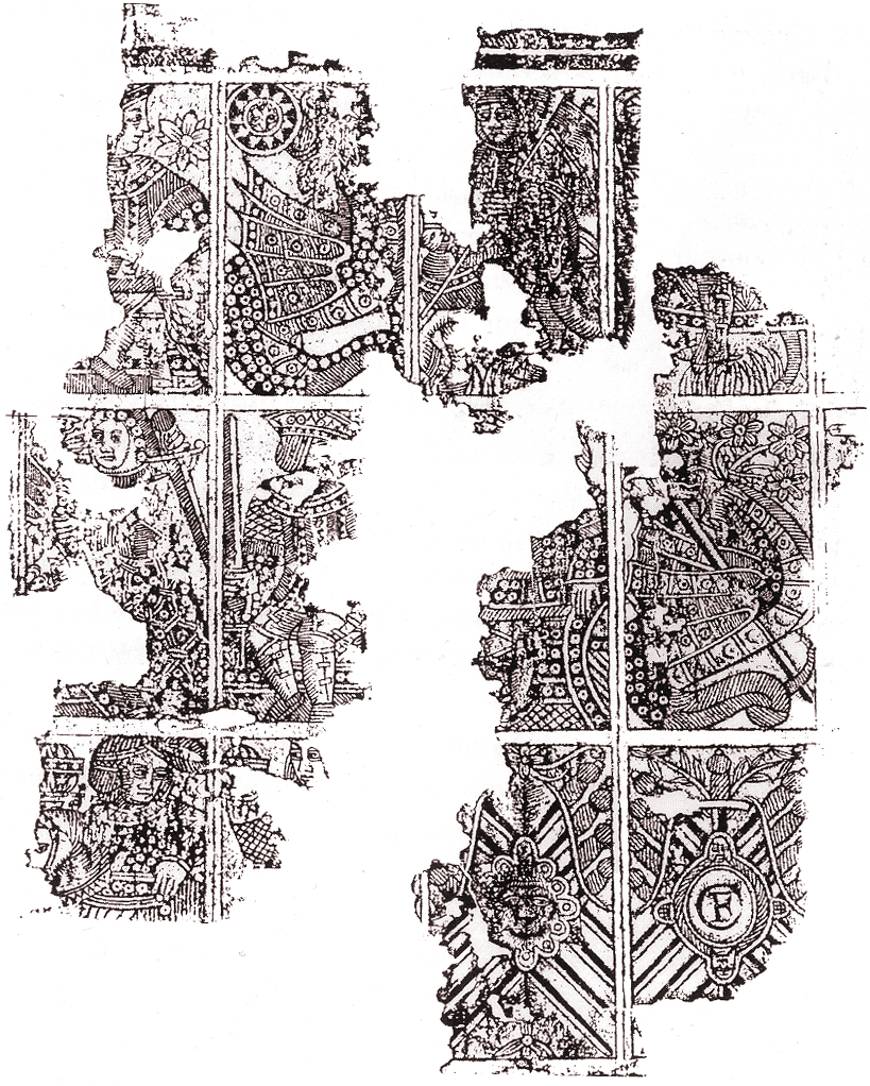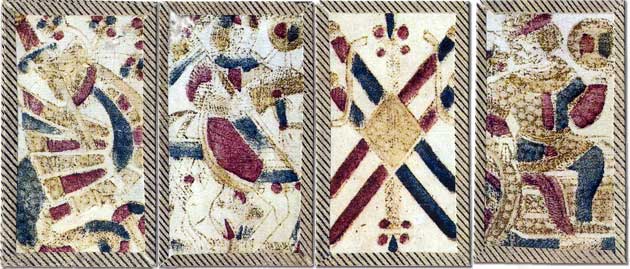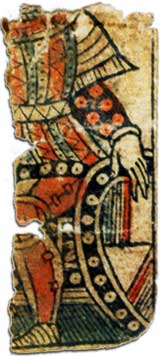Early Spanish/Portuguese type
Fragment of a sheet of archaic Spanish-suited 'Dragon' playing cards found during restoration of a house in Antwerp built between 1559 and 1574
Fragment of a sheet of archaic Spanish-suited ‘Dragon’ playing cards found during restoration of a house in Antwerp built between 1559 and 1574, a period during which the histories of Spain and the Netherlands were connected.
The history of the Spanish Netherlands covers the period from 1556 when, after the abdication of Emperor Charles V, they became the inheritance of his son, King Philip II of Spain, becoming known as the Spanish Netherlands. This period ran until 1715, when the remaining Southern Netherlands came under the authority of the Austrian emperor.

Above: fragment of a sheet of archaic Spanish-suited ‘Dragon’ playing cards found during restoration of a house in Antwerp built between 1559 and 1574, in a period in which the histories of Spain and the Netherlands were intricately connected. The initials ‘FC’ can be seen on the 9 of swords. The aces feature sea dragons holding the suit symbol; the courts are a seated king, a horse-man and a female page. Cards of this type spread to many parts of the world: examples have been made in, or associated with Italy, Sicily, Portugal, Malta, Spain, Belgium, Brazil, Japan, India and Indonesia.
See also: Francisco Flores, Rimac Valley Excavations in Peru, The South German Engraver.

By Simon Wintle
Member since February 01, 1996
I am the founder of The World of Playing Cards (est. 1996), a website dedicated to the history, artistry and cultural significance of playing cards and tarot. Over the years I have researched various areas of the subject, acquired and traded collections and contributed as a committee member of the IPCS and graphics editor of The Playing-Card journal. Having lived in Chile, England, Wales, and now Spain, these experiences have shaped my work and passion for playing cards. Amongst my achievements is producing a limited-edition replica of a 17th-century English pack using woodblocks and stencils—a labour of love. Today, the World of Playing Cards is a global collaborative project, with my son Adam serving as the technical driving force behind its development. His innovative efforts have helped shape the site into the thriving hub it is today. You are warmly invited to become a contributor and share your enthusiasm.
Related Articles

Barok
Dutch pack from the 1950s with colourful Baroque courts, reprinted in 1983.

Trappola cards from Poland
Trappola cards published in Warsaw by J G Du Port during the 18th century.

Verkeers Kwartet
A helpful quartet game celebrating the 75th anniversary of road safety exams making traffic safer.

Laurenzo Propagine
Spanish-suited cards made in Italy by Laurenzo Propagine.

Portuguese pattern by Real Fábrica
Later Portuguese pattern by Impressão Règia, Real Fábrica de Lisboa.

Rouen Pattern - Portrait Rouennais
An attractive XV century French-suited design from Rouen became the standard English & Anglo-America...

Archaic Spanish proof sheets
2 x uncoloured proof sheets of archaic Spanish-suited playing cards produced for “New Spain”, possib...

Het Olympisch kaart- en kwartetspel
Dual-purpose set featuring photos of sporting figures from the Netherlands on every card.

Ganjifa - Playing Cards from India
Indian playing cards, known as Ganjifa, feature intricate designs with twelve suits and are traditio...

The Henry Hart Puzzle
Explore the intricate history and unique design variations of Henry Hart's playing cards, tracing th...

Sevilla 1647 reproduction
Facsimile of Spanish-suited pack produced in Sevilla, Spain, 1647.

Why our playing-cards look the way they do
Analysis of early playing card designs: origins, suit differences, standardization, technological ad...

Kojak bubble gum cards
Bubble gum cards featuring stills – mainly of Telly Savalas – from the cult TV series Kojak.

Introduction to Collecting Themes
Playing cards can be broadly categorised into standard and non-standard designs, with collectors app...

Le Monde Primitif Tarot
Facsimile edition produced by Morena Poltronieri & Ernesto Fazioli of Museo Internazionale dei Taroc...

Burgundy pattern - portrait bourguignon
The old Burgundy (or Burgundian) pattern by Nicolas Chenevet, Dijon.
Most Popular
Our top articles from the past 28 days



